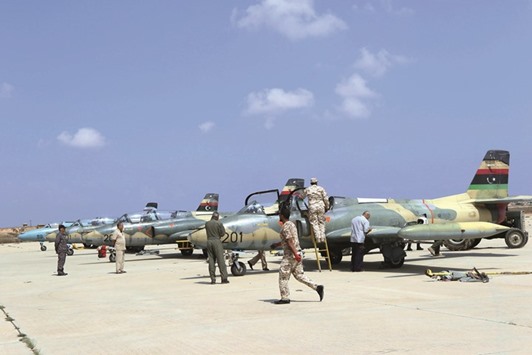Yellow-and-blue fighter jets sit neatly lined up on the tarmac at the air force academy in Libya’s Misrata, no longer awaiting students but orders for strikes against the Islamic State group.
The military college has been transformed into a major base in the battle against the militants since they gained ground in the country in the turmoil that followed the 2011 uprising.
For a year and half its planes – flown mainly by former instructors in their 40s and 50s – have been carrying out strikes against IS, and for several months they have been targeting what was their main stronghold in North Africa.
IS took over Sirte some 250km (150 miles) east of Misrata in June last year, sparking fears the militants would use the Mediterranean city as a launchpad for attacks in Europe.
Forces loyal to the UN-backed government this June fought their way into Sirte and have since pushed back IS fighters into one last district of the city.
At the air force academy in Misrata, two pilots board a fighter jet don their helmets and wait for the signal to fly off on a reconnaissance mission of IS targets.
“We know this terrorist organisation operates worldwide,” Brigadier-General Rajab Abdaraheem says, referring to IS.
“When I’m up in the air about to hit an IS target, I feel like I’m defending my country and the world,” says the 57-year-old pilot who has been flying since he graduated in 1982.
Since it opened in 1975, more than 30 classes of around 1,000 trainee pilots have graduated from the academy.
The school trained officers from Libya and other countries in the Arab world until the 2011 uprising that toppled and killed longtime dictator Muammar Gaddafi.
The academy saw heavy fighting between the rebels and fighters loyal to Gaddafi and was damaged in Nato strikes backing the opposition who retook the area.
The door of the main maintenance hangar at the academy is still peppered with bullet holes.
After 2011 “we renovated the facilities but when the situation in Libya didn’t stabilise the academy became a (military) base,” says Brigadier-General Abderahman Mohamed.
Officers – most of whom had graduated for the academy in the 1980s and 1990s – transformed the college’s training aircraft into warplanes, equipping them with rockets and missiles, they say.
The aircraft date mainly from the Gaddafi era and include some two dozen ageing jets including Russian-made MiG-23s, Yugoslav Soko G-2 Galebs and Czech L-39s, as well as helicopters.

Staff members of the Libyan Air Force next to fighter jets on the tarmac of the Air College, that was turned into an air base for jets targeting the positions of the Islamic State (IS) group in Sirte as well as in the north-central and north-western Libya.


